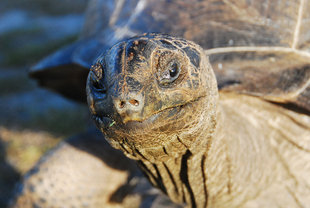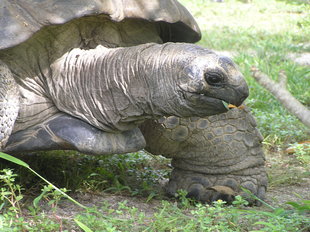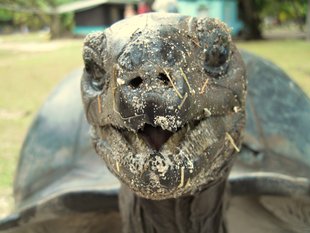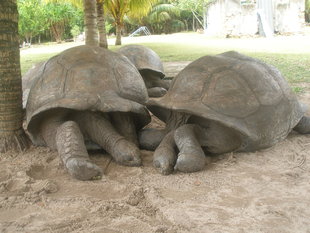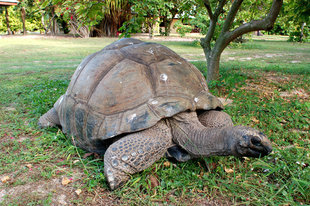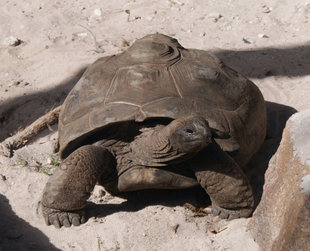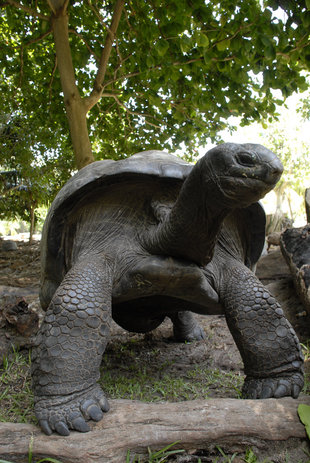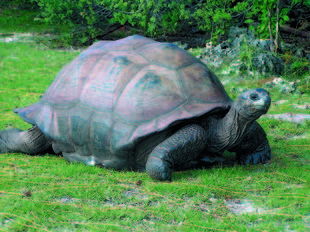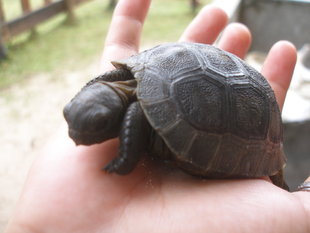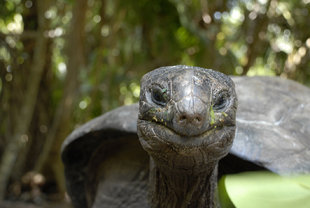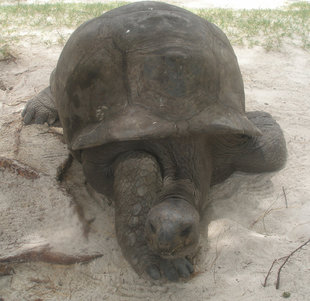Name: Aldabra Giant Tortoise (Dipsochelys dussumieri)
Length: up to 1.4 metres / 5 feet
Weight: up to 250 kg
Introduction
Aldabra Giant Tortoises are endemic to Aldabra, but are also commonly kept in captivity throughout the Seychelles archipelago and many feral populations on several of the islands. The original endemic giant tortoise species of the granitic islands is long extinct in the wild, however, individuals still remain that display characteristics of two of these species - the Seychelles Giant Tortoise and the Arnold's Tortoise. These two tortoises are currently part of a captive breeding programme on Silhouette. Another isolated population of this species also resides on the island of Zanzibar, while other captive breeding populations exist within conservation parks in Mauritius and Rodrigues.
Identification
These large slow-moving tortoises are some of the biggest giant tortoises in the world. They are unmistakable and are the only free-ranging tortoise species to exist in the Seychelles, with individuals living for over 100 years.
Description
Aldabra tortoises are very large and have a high-domed, dark grey/brown carapace (which averages up to 120 cm in length) and thick grey wrinkled skin. Males are generally larger in size to female, with longer tails and a depression on their underside. They have club shaped front legs, with thick and sturdy back legs - ideal for supporting their hefty weight. They have a large, blunt head, attached to a long and thick retractable neck, which helps them to exploit tree branches up to a metre from the ground as a food source. Their eyes are dark and nostrils large.
Voice
When Aldabra tortoises are scared or feeling threatened, they retract their heads into their shell and make a hissing sound as they expel air from their lungs. During copulation, males will roar loudly, whereas females will remain silent.
Behaviour
These tortoises are most active during the cooler parts of the day, generally first things in the morning and in the late afternoon. During the hottest parts of the day, they seek shady spots to rest in and escape the heat.
They eat a diet of tie grasses, shrubbery and plants which have evolved in response to their feeding patterns. Many distinct plants have naturally dwarfed themselves and evolved to growing their seeds close to the ground rather than from the tops of the plants to avoid the tortoises chomping jaws. Although primarily herbivores, they have also been known to eat small invertebrates and carrion and even the bodies of other dead tortoises. Due to the harsh, dry and arid environment of Aldabra in which the tortoises reside and lack of natural water sources, they have to obtain most of their moisture from their food.
They can swim relatively well but walk slowly whilst on land. Other than mating, individuals rarely interact with one another, living out their existence peacefully by themselves.
Breeding
Mating generally occurs towards the end of the northwest monsoon season (February - May) and individuals will typically lay their eggs during the drier southeast monsoon season (June - September). Females will normally lay between 10 and 25 eggs in a nest hole, which they construct at night and cover with sand. Eggs tend to take between 70 and 60 days to hatch, depending on the temperature. Come nightfall, hatchlings, which measure around 70 mm in length, emerge from the shells.
Aldabra Tortoise

